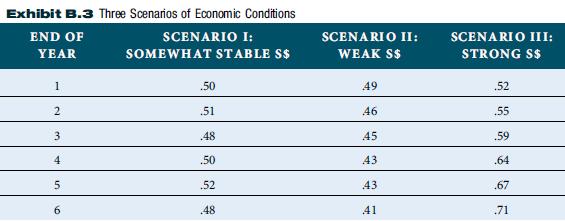This case is intended to illustrate that the value of an international project is sensitive to various
Question:
This case is intended to illustrate that the value of an international project is sensitive to various types of input. It also is intended to show how a computer spreadsheet format can facilitate capital budgeting decisions that involve uncertainty.
This case can be performed using an electronic spreadsheet such as Excel. The following present value factors may be helpful input for discounting cash flows:

For consistency in discussion of this case, you should develop your computer spreadsheet in a format somewhat similar to that in Chapter 14, with each year representing a column across the top. The use of a computer spreadsheet will significantly reduce the time needed to complete this case.
North Star Company is considering establishing a subsidiary to manufacture clothing in Singapore. Its sales would be invoiced in Singapore dollars (S$). It has forecasted net cash flows to the subsidiary as follows:

These cash flows do not include financing costs (interest expenses) on any funds borrowed in Singapore. North Star Company also expects to receive S$30 million after taxes as a result of selling the subsidiary at the end of Year 6. Assume that there will not be any withholding taxes imposed on this amount.
The exchange rate of the Singapore dollar is forecasted in Exhibit B.3 based on three possible scenarios of economic conditions.
The probability of each scenario is shown below:

Fifty percent of the net cash flows to the subsidiary would be remitted to the parent, while the remaining 50 percent would be reinvested to support ongoing operations at the subsidiary. North Star Company anticipates a 10 percent withholding tax on funds remitted to the United States.
The initial investment (including investment in working capital) by North Star in the subsidiary would be S$40 million. Any investment in working capital (such as accounts receivable, inventory, etc.) is to be assumed by the buyer in Year 6. The expected salvage value has already accounted for this transfer of working capital to the buyer in Year 6.
The initial investment could be financed completely by the parent ($20 million, converted at the present exchange rate of $.50 per Singapore dollar to achieve S$40 million).

North Star Company will go forward with its intentions to build the subsidiary only if it expects to achieve a return on its capital of 18 percent or more.
The parent is considering an alternative financing arrangement. With this arrangement, the parent would provide $10 million (S$20 million), which means that the subsidiary would need to borrow S$20 million. Under this scenario, the subsidiary would obtain a 20-year loan and pay interest on the loan each year. The interest payments are S$1.6 million per year. In addition, the forecasted proceeds to be received from selling the subsidiary (after taxes) at the end of 6 years would be S$20 million (the forecast of proceeds is revised downward here because the equity investment of the subsidiary is less; the buyer would be assuming more debt if part of the initial investment in the subsidiary were supported by local bank loans). Assume the parent’s required rate of return would still be 18 percent.
a. Which of the two financing arrangements would you recommend for the parent? Assess the forecasted NPV for each exchange rate scenario to compare the two financing arrangements and substantiate your recommendation.
b. In the first question, an alternative financing arrangement of partial financing by the subsidiary was considered, with an assumption that the required rate of return by the parent would not be affected. Is there any reason why the parent’s required rate of return might increase when using this financing arrangement? Explain. How would you revise the analysis in the previous question under this situation? (This question requires discussion, not analysis.)
c. Would you recommend that North Star Company establish the subsidiary even if the withholding tax is 20 percent?
d. Assume that there is some concern about the economic conditions in Singapore, which could cause a reduction in the net cash flows to the subsidiary. Explain how Excel could be used to reevaluate the project based on alternative cash flow scenarios. That is, how can this form of country risk be incorporated into the capital budgeting decision?
(This question requires discussion, not analysis.)
e. Assume that North Star Company does implement the project, investing $10 million of its own funds with the remainder borrowed by the subsidiary. Two years later, a U.S.-based corporation notifies North Star that it would like to purchase the subsidiary.
Assume that the exchange rate forecasts for the somewhat stable scenario are appropriate for Years 3 through 6. Also assume that the other information already provided on net cash flows, financing costs, the 10 percent withholding tax, the salvage value, and the parent’s required rate of return is still appropriate. What would be the minimum dollar price (after taxes) that North Star should receive to divest the subsidiary? Substantiate your opinion.
Step by Step Answer:






